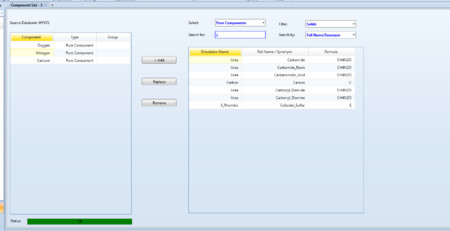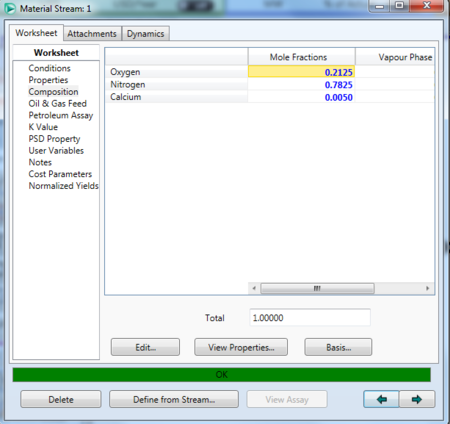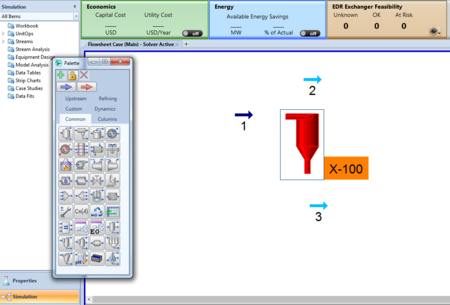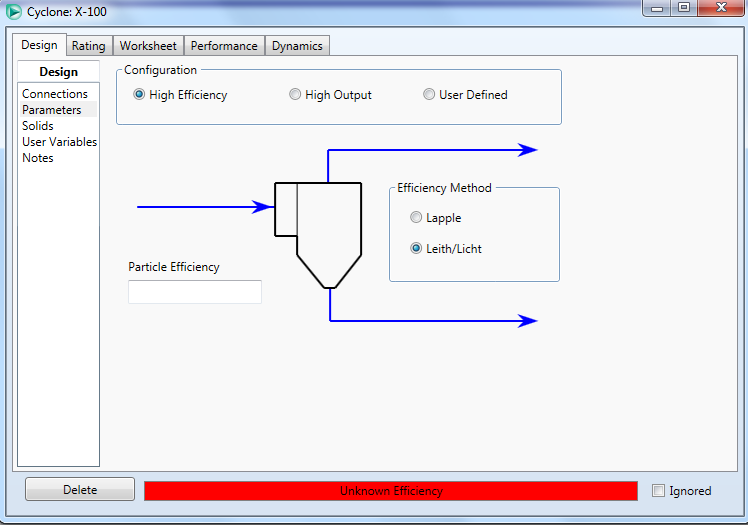Solids-involved equipment: Difference between revisions
No edit summary |
|||
| Line 30: | Line 30: | ||
To begin the appropreate gases (in this case nitrogen and oxygen,) must be added to the simulation along with the solid. HYSYS does not have many solids to choose from in the simulation. This simulation will remove calcium particles mixed in an air stream. [[File:1st_add_component.PNG|450x500px]] | To begin the appropreate gases (in this case nitrogen and oxygen,) must be added to the simulation along with the solid. HYSYS does not have many solids to choose from in the simulation. This simulation will remove calcium particles mixed in an air stream. [[File:1st_add_component.PNG|450x500px]] | ||
The choice of fluid package depends greatly on the fluids and the operating conditions. In this case the general NRTL is sufficient. [[File:2nd choose fluid package.PNG|450x500px]] | The choice of fluid package depends greatly on the fluids and the operating conditions. In this case the general NRTL is sufficient. | ||
[[File:2nd choose fluid package.PNG|450x500px]] | |||
From here the simulation environment is ready. Start by specifying a feed stream. In this case a feed of air with a small amount of calcium is specified. [[File:3 specify composition.PNG|450x500px]] | From here the simulation environment is ready. Start by specifying a feed stream. In this case a feed of air with a small amount of calcium is specified. [[File:3 specify composition.PNG|450x500px]] | ||
Revision as of 23:08, 5 February 2016
Author: John Marsiglio [2016]
Stewards: Daniel Garcia and Fengqi You
Introduction and Overview
Solids-involed equipment is an important aspect of many processes. Solids are often more difficult to handle than liquids because the process equipment consumes more energy to operate, are more prone to mechanical failure, and can create dust. Dusts can be very dangerous. They can cause respiratory illnesses and in cases of combustible dust such as the Domino sugar plant, cause explosions in confined spaces. Flow of solids is also difficult to predict. While rheology is a well studided field for fluids, powder rheology is not a well characterized field. There are many pieces of process equipment aimed at handling solids. A bin is a vertical vessel used for storing solids. Large bins with with roughly a height to diameter ratio of 1.5 are called silos. Bins with height to diameter ratio less than this are called bunkers. From a silo or bunker solids will move out of an orrifcae, or hopper, to a feeder. Solids may be conveyed in a number of ways. The most familiar of these ways is a belt conveyer, like the ones used at the Domino sugar plant. There are also screw conveyors, which are used to convey free-flowing solids over short distances. Screw conveyors have been used since the time of archemides who made them famous with his archemedies screw. Other types include hydraulic and pneumatic conveyors.
Industrial Separation of Solids
Currently there are many different ways to separate solids from liquids or gases. The most industrially important pieces of equipment are used to separate solid particles from gasses. A sector of this field, known as air pollution control is often glossed over in most chemical engineering undergraduate courses. However, it is an extremely important topic in industrial chemical plant design for reasons of employee health and EPA guidlines. However, there are other reasons to separate solids from gases, such as to prevent buildup of combustible dusts, as in the instance of the Domino sugar factory explosion.
Gravity Settlers
As the name implies, gravity settlers are simply a long chamber through which gas-solid systems are sent. Large particle sizes (>50um) can be removed from the system this way.
Cyclones
When a gravity settler is insufficient, centrifugal separation can be employed. This piece of process equipment is known as a cyclone. A cyclone resembles an inverted cone, in which solid-gas systems enter along the side, and gas exits at the top. Solids then fall out the bottom. See figure 1 for more details. Cyclones are particularly efffective, able to handle particulate sizes down to 5um, and with no moving parts make them an industry favorite.
Baghouses
The particle control measure that the average consumer would be most familiar with would be the baghouse. A baghouse is a simple concept of many filters, and dust collection in bags, much like the home vacuum cleaner. This system diverges from the home vacuum cleaner bag in that these filters must be periodically cleaned, and some are coated in a viscous mineral oil to help trap dust. The can handle particulates down to 10um.
Scrubbers
Wet scrubbing is a very effective method for reducing dust in gas streams. A typical wet scrubbing system features a solid-gas stream flowing concurrently to a liquid, generally water, stream. When particles impact the water stream they become trapped. Wet scrubbers can remove particle sizes down to 0.5um. While effective scrubbers are also expensive, which is why other less expensive means of air pollution control are often employed.
Electrostatic Precipitators
Electrostatic Precipitators, or ESPs, are some of the most effective air pollution control equipment. They can remove particulates dowbn to 0.5um. To do so gas-solid streams in an ESP pass between two plates of negative and positive charge. These plates are able to collect particles based on their charges. While incredible effective constructing and operating an ESp is very expensive, which is why they are only used when necessary in industry.
HYSYS Simulation
AspenTech HYSYS can be a powerful tool to simulate the use of solids involved equipment in handling solids. One widely used piece of solids involved equipment is the cyclone which, in its many forms, can be used to remove solids from a gas stream.
To begin the appropreate gases (in this case nitrogen and oxygen,) must be added to the simulation along with the solid. HYSYS does not have many solids to choose from in the simulation. This simulation will remove calcium particles mixed in an air stream. 
The choice of fluid package depends greatly on the fluids and the operating conditions. In this case the general NRTL is sufficient.

From here the simulation environment is ready. Start by specifying a feed stream. In this case a feed of air with a small amount of calcium is specified. 
Next the cyclone can be placed in the environment, and the appropriate streams may be attached to the appropriate positions. The simulation should look something like below. 
The cyclone needs a few specifications before the simulation will converge. Under parameters the efficiency method and particle efficiency must be specified. The Lapple method is the simplier of the two and generally good, although in some cases the Leith-Licht theory is a better approximation. Either is fine for this simulation. Particle efficiencies for cyclones generally run on the order of 50-80%.
